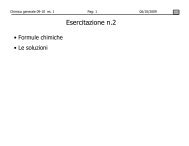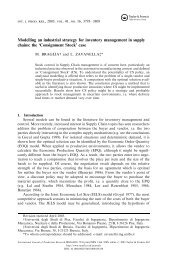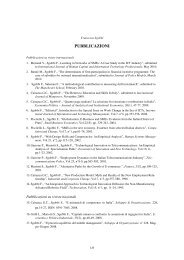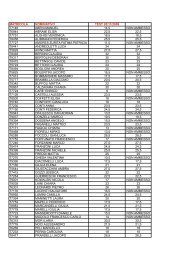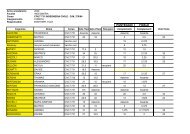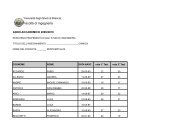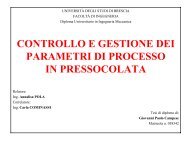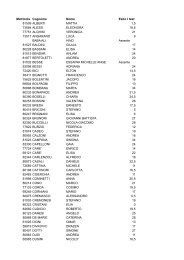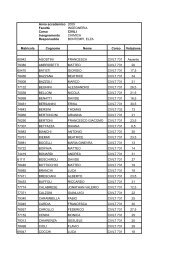The consignment stock of inventories: industrial ... - ResearchGate
The consignment stock of inventories: industrial ... - ResearchGate
The consignment stock of inventories: industrial ... - ResearchGate
Create successful ePaper yourself
Turn your PDF publications into a flip-book with our unique Google optimized e-Paper software.
Int. J. Production Economics 81–82 (2003) 215–224<strong>The</strong> <strong>consignment</strong> <strong>stock</strong> <strong>of</strong> <strong>inventories</strong>: <strong>industrial</strong> case andperformance analysisGiovanni Valentini a , Lucio Zavanella b, *a IESE Business School, Barcelona, Spainb Universit "a degli Studi di Brescia, Dp.to Ing. Meccanica, Facolt"a di Ingegneria, Via Branze, 38, I-25123 Brescia, ItalyAbstract<strong>The</strong> ‘‘Consignment Stock’’ technique is a novel approach to the management <strong>of</strong> <strong>inventories</strong> in supply chains. It isbased on an improved collaboration between the company and its suppliers, one that is acquiring growing importancein <strong>industrial</strong> environments, as the authors have found in Italy. <strong>The</strong> main aim <strong>of</strong> the present work is to describe thetechnique itself, thus underlining its potential benefits and pitfalls. <strong>The</strong> case proposed refers to a companymanufacturing components for the automotive industry. Essentially, the company <strong>of</strong>fered its suppliers the opportunity<strong>of</strong> <strong>stock</strong>ing part <strong>of</strong> the items in its own warehouses, with the agreement that they would guarantee over time aninventory level between a set minimum and a maximum value.r 2002 Elsevier Science B.V. All rights reserved.Keywords: Supply chain; Inventory management; Consignment <strong>stock</strong>1. Introduction and <strong>consignment</strong> <strong>stock</strong> practice<strong>The</strong>re is no question that over the past decadesan increasing amount <strong>of</strong> research has concernedthe importance <strong>of</strong> establishing a pr<strong>of</strong>itable verticalrelationship between companies and suppliers,especially in management literature. In particular,strong interaction and reliable collaboration betweenthese two actors have emerged as strategicissues and powerful instruments for maintainingor acquiring competitive advantages in a dynamicand selective market. Indisputably, this issue alsoplays a pivotal role in inventory policies and*Corresponding author. Tel.: +39-0303715579; fax: +39-0303702448.E-mail address: zavanell@ing.unibs.it (L. Zavanella).management. Yet, despite the growing number <strong>of</strong>studies and theoretical models developed, theoperational research still seems to be frequentlydivorced from <strong>industrial</strong> reality. Meanwhile, severalpractices that are not dealt with in theliterature show up, acquire importance, and proveto be successful.This is the case <strong>of</strong> <strong>consignment</strong> <strong>stock</strong> (CS)management <strong>of</strong> provisioning, which, regardless <strong>of</strong>some similarities with the common (s, S) policy,reveals significant innovative contributions.Nowadays, this practice has been widely adoptedin Italy, and is consistently gaining consensusamong both small and large firms. Both businesspress and private sources have also confirmedrecent CS applications between Italy and othercountries. Under a CS policy, the relationship0925-5273/02/$ - see front matter r 2002 Elsevier Science B.V. All rights reserved.PII: S 0925-5273(02)00300-6
216G. Valentini, L. Zavanella / Int. J. Production Economics 81–82 (2003) 215–224between a company and a supplier is based on thefollowing simple rules:1. <strong>The</strong> supplier will guarantee the company thecontinuity <strong>of</strong> an available <strong>stock</strong> between aminimum level s and a maximum level S: the<strong>stock</strong> will be stored in the company’s rawmaterial depots, close to the production lines.2. <strong>The</strong> company may draw on raw materials daily,according to its needs. <strong>The</strong> supplier is paid forthese materials according to their agreement,hypothetically up to a daily frequency, so thatthe information concerning the consumptiontrend is also constantly refreshed and immediatelytransferred to the supplier.In such a way, the continuous replenishmentfrom the supplier protects the company againstdemand fluctuations and costs determined byeventual <strong>stock</strong>out may also be debited to thesupplier, by means <strong>of</strong> contract penalties. On theother hand, the supplier has a better perception <strong>of</strong>his customer’s requirements: lower <strong>stock</strong>ing costsare incurred and the continuous evolution <strong>of</strong>market demand is directly perceived thanks to anelectronic data interchange (EDI) interface. Severalbenefits are immediately evident:1. <strong>The</strong> company always has raw material available.2. <strong>The</strong> company pays for raw material consumptiononly when the items are drawn on for use.3. <strong>The</strong> supplier saves holding costs and mayorganise his production in different ways, alsowith respect to eventual third parties.4. A renewed and reinforced link is set up betweenthe company and its supplier.However, CS requires the accurate definition <strong>of</strong>various parameters, i.e. s and S; and a constantattention to the information flow, that is, theelectronic transmission to the supplier <strong>of</strong> itemconsumption. On this basis, the supplier canforesee the consequences <strong>of</strong> a better management<strong>of</strong> his own production, being freed from thebounds implicit in the strict EOQ practice (e.g.handling large but infrequent orders).This paper seeks to provide a coherent frameworkwithin which to understand the success <strong>of</strong>CS. We ask why these changes are taking place. Isit a mere coincidence that various firms areadopting CS policies or is there a rationale behindtheir choice? If this is the case, how should theirchoice be implemented?So as to grasp both the why and the how <strong>of</strong> CS,the rest <strong>of</strong> the paper is organised as follows.Section 2 briefly presents the main results <strong>of</strong> theliterature, while Section 3, using the results <strong>of</strong> acomputational simulation, shows how CS policymay outperform previous models. In other words,we provide a tentative pro<strong>of</strong> that CS is a rationalchoice. Section 4 addresses the main tacticalquestions that follow the decision to adopt CS.This problem is tackled with the benefit <strong>of</strong> insights<strong>of</strong>fered by a case study. Concluding remarksfollow.2. Literature reviewOne <strong>of</strong> the major outcomes <strong>of</strong> the inventorytheory has been to show that (s, S) policies areoptimal for a class <strong>of</strong> dynamic inventory modelswith random periodic demands and fixed orderingcosts. Under a common (s, S) policy, if theinventory level at the beginning <strong>of</strong> a period islower than the reorder point s; then a sufficientquantity must be ordered to achieve an inventorylevel S: Literature on the subject is ample andcovers a wide time span. E.g., Iglehart (1963)obtained the stationary distribution <strong>of</strong> the inventory/backlogand developed an explicit formulafor evaluating the stationary average cost, with theappropriate assumptions. Zheng (1991) has provideda rigorous pro<strong>of</strong> <strong>of</strong> the optimality <strong>of</strong> an (s, S)policy for the model <strong>of</strong> Veinott and Wagner(1965). Sethi and Cheng (1997) broadened somepreviously rigid assumptions in favour <strong>of</strong> morerealism, and still demonstrated the optimality <strong>of</strong>(s, S) policies dealing with a given distribution <strong>of</strong>demand.In general, many practical inventory replenishmentproblems satisfy reasonably well the mathematicalconditions under which this type <strong>of</strong> policyis convenient; however, complex analytical methodsfor computing the best (or even ‘‘a good’’)policy are rarely used, because, according to somepractitioners, they are prohibitively expensive.
G. Valentini, L. Zavanella / Int. J. Production Economics 81–82 (2003) 215–224 217Several researches tried to show that this objectiondoes not respond to reality. Generally speaking,inventory models have been discussed extensivelyin literature, whereas the treatment <strong>of</strong> interactionsbetween buyers and suppliers has developed morerecently (Goyal and Gupta, 1989). In 1977, Goyal(Goyal, 1977) suggested a joint economic lot sizemodel where the objective is to minimise the totalrelevant costs for both the vendor and the buyer.<strong>The</strong> model was generalised by Banerjee (1986) andGoyal (1988) himself. While these later modelsassume that there’s a perfect balance <strong>of</strong> powerbetween the vendor and the buyer, enforced bycontractual agreement, there are also modelsdeveloped so as to minimise the vendor’s totalannual cost subject to the maximum cost that thebuyer may be prepared to incur (e.g. Lu, 1995).However, it is clear how a partnership may bestrategically useful to both sides, and how it canimprove the inventory management policies (i.e.reduce the costs) by loosening some constraints.This is described in Hill (1997), who introduced areference model in an integrated perspective. Heshowed how the system as a whole can enjoysignificant improvements without any relevant lossfor the parties.To summarise, the literature highlights thetheoretical optimality <strong>of</strong> (s, S) policies, but it isinconclusive on a lot <strong>of</strong> issues regarding the levels<strong>of</strong> inventory, variables to which the results <strong>of</strong> themodel are very sensitive. Moreover, the benefits <strong>of</strong>a collaboration between companies and suppliersare not taken into account: in other words,suppliers’ costs are not considered a key variable.On the other hand, the models that allow forpr<strong>of</strong>itable interaction between the parties <strong>of</strong>tenlack the flexibility and the practicality <strong>of</strong> general(s, S) policies, and provide complex formulas <strong>of</strong>order quantities.As we shall see, CS seeks to use the best <strong>of</strong> bothapproaches.3. Considerations on CS fundamentals<strong>The</strong> basic idea <strong>of</strong> CS consists in the fact that thephysical inventory <strong>of</strong> raw material resides withinthe company, ranging freely in quantity between aminimum required level s and a maximumpermitted level S: In addition, under the agreement,the material is formally purchased only atthe moment <strong>of</strong> its consumption. In other words,even if the raw material is stored in the company’swarehouse, it is still ‘‘owned’’ by the supplier. Letus see what changes in the cost structure this policyentails.We may think <strong>of</strong> the per unit inventory cost h asdriven by two main components: a financial one(h fin ) and a storage one (h <strong>stock</strong> ). <strong>The</strong> financial partregards the opportunity costs a firm incurs whileinvesting financial resources in producing a good.<strong>The</strong> operational component has to do with thepure storage and movement costs, insurance costs,etc. Under a typical supply agreement, these costsare borne as indicated in Table 1. That is, eachfirm, the supplier and the company in turn,sustains the entire inventory cost (both thefinancial and the storage components) as determinedby the firms’ endogenous characteristicswhile the material is stored in their warehouse. Inthe simplest terms, no inventory cost is sustainedby the supplier after delivering the goods, and nocost is borne by the company before the delivery.Finally, it should be noted that h c;fin þ h c;<strong>stock</strong> isgenerally greater than h s;fin þ h s;<strong>stock</strong> ; mainly because<strong>of</strong> the financial component, which increasesas it goes down the supply chain. <strong>The</strong> differentsituation brought about by CS is outlined inTable 2.As can clearly be seen, the main difference is tobe found in the case where the material has alreadybeen delivered to the company. In fact, thecompany incurs the storage cost, given that thematerial is located in its warehouse, but it doesnot yet sustain the financial cost. In fact, given thata good is formally purchased only after itsTable 1Relevant inventory costs in traditional agreementsPosition <strong>of</strong> raw materialSupplierCompanyRelevant costs Supplier h s;fin þ h s;<strong>stock</strong> 0Company 0 h c;fin þ h c;<strong>stock</strong>
218G. Valentini, L. Zavanella / Int. J. Production Economics 81–82 (2003) 215–224Table 2Relevant inventory costs under CS policyPosition <strong>of</strong> raw materialSupplierCompanyRelevant costs Supplier h s;fin þ h s;<strong>stock</strong> h s;finCompany 0 h c;<strong>stock</strong>consumption, the supplier is still bearing thefinancial opportunity cost. 1 Thus, while calculatingthe total cost for the system, we may reasonablyassume that the storage component h <strong>stock</strong> <strong>of</strong>the total inventory cost may be considered as moreor less identical for the supplier and the company,i.e. h c;<strong>stock</strong> ¼ h s;<strong>stock</strong> : As a consequence, referring tothe same average <strong>stock</strong> level, the total storage cost<strong>of</strong> the system is lower in the CS case (as we assumeh c;fin > h s;fin ), even if a part <strong>of</strong> the cost is ‘‘shifted’’onto the supplier. However, the supplier perceivessome advantages as counterpart: (i) the averagequantity <strong>of</strong> the material stored in his own<strong>inventories</strong> decreases and, consequently, (ii) spaceis available to allocate other items; finally, (iii) thesupplier may manage his production plan moreflexibly as it is not constrained by closed-orders.On the other hand, the company ‘‘sees’’ a lowerper unit inventory cost, that is, only h c;<strong>stock</strong> instead<strong>of</strong> the entire (h c;fin þ h c;<strong>stock</strong> ). 2Furthermore, it should be noted that there is nolonger any administrative cost for placing anorder, as, in fact, there is no longer any order. 3It should be added that, in some applications <strong>of</strong>CS strategy, the item carrier may also be involvedin the partnership, as it may delivery goods fromdifferent suppliers and update the information oninventory levels.To give substance to our arguments, we will tryto show more formally how adopting the CSpolicy improves the performance <strong>of</strong> the company/1 Obviously, we are not considering the delay between thepurchase and the payment by the company. Still, our argumentholds ceteris paribus.2 Admittedly, the average quantity stored in its own<strong>inventories</strong> may be larger.3 Because <strong>of</strong> the EDI interface between the company and thesupplier.supplier system; more specifically we will compareit to Hill’s model (Hill, 1997) while dealing withGoyal’s (1988) classic example. <strong>The</strong> followingnumerical values and parameters are taken intoaccount: 4A 1 =supplier’s set-up cost=400$,A 2 =cost <strong>of</strong> placing one order=25$h 1 =supplier’s inventory cost/unit=4$,h 2 =company’s inventory cost/unit=5$,D=demand rate=1000 units/year,P=production rate=3200 units/yearn=number <strong>of</strong> deliveries per lot.<strong>The</strong> ‘delivery lead-time’ is set equal to zero.According to Hill (1997), the order quantity q that minimises Cðn; qÞ; the average joint cost perunit <strong>of</strong> time, is given byq ¼s ffiffiffiffiffiffiffiffiffiffiffiffiffiffiffiffiffiffiffiffiffiffiffiffiffiffiffiffiffiffiffiffiffiffiffiffiffiffiffiffiffiffiffiffiffiffiffiffiffiffiffiffiffiffiffiffiffiffiffiffiffiffiffiffiffiffiffiffiffiffiffiffiffiffiffiffiffiffiffiffiffiffiffiffiffiffiffiffiffiffiffiffiffiffiffiffiffiffiffiffiffiffiffiffiðA 1 þ nA 2 Þ D Dh 1n P þ ðP DÞn þ h 2 h 11:2P 2Applying the classic EOQ solution (Buffa andSarin, 1987), we would get an optimal EOQ <strong>of</strong> 100items. Hill’s solution identifies a minimum cost <strong>of</strong>1903$ in correspondence to a modified EOQ ¼ 110and an EPQ ¼ 550; thus providing the condition<strong>of</strong> minimum cost for the whole buyer–vendorsystem.In order to compare Hill’s model to CS, a series<strong>of</strong> tests has been run.If the cost function is modified according to theCS policy as described in Table 2, (i.e. removingcompany order costs and splitting the inventorycosts into a financial component and in a storageone <strong>of</strong> equal amount), 5 Fig. 1 is obtained: itrepresents the total average joint costs—on thebasis <strong>of</strong> a 20-year period 6 —depending on the Slevel (s is set to zero, because <strong>of</strong> the null lead-timeassumption).4 In the model there is no transportation cost. This may berealistic, for instance, when geographical proximity is assumed.Goyal assumes linear costs to be usual.5 Results depend on this assumption, but a basic sensitivityrevealed how simulation main outcomes hold for a wide enoughrange <strong>of</strong> h <strong>stock</strong> and h fin :6 This assumption is made in order to obtain better qualitygraphs, but it does not influence the indications <strong>of</strong>fered by theanalysis carried out.
G. Valentini, L. Zavanella / Int. J. Production Economics 81–82 (2003) 215–224 219Fig. 1. Total joint costs in the CS policy depending on S:Fig. 2. Hill’s model costs depending on S in the case <strong>of</strong> a nondeterministicdemand.At the present stage, it may even be misleadingto take into account all the variables at stakewhich may determine the supplier deliveries inbetween s and S: Thus, we assumed that when s isreached, an (S2s) quantity is immediately deliveredby the supplier. <strong>The</strong> minimum cost obtainedis 1793$, in correspondence to S ¼ 426: AdoptingCS policy and the cost savings implicit in it, it istherefore possible to achieve a 6% reduction in thetotal cost. Moreover, neither the supplier’s allowedflexibility and the company’s reliability in guaranteeingservice levels were quantified in monetaryterms, in spite <strong>of</strong> their indisputable value.Even if it is quite obvious to obtain a reducedcost with respect to Hill’s model (as some costs arelower), the test results show that this CS performancedepends on the S level fixed. Thus, a firstinsight is possible: when the company and itssupplier bargain the CS agreement, they must takeinto account that the convenient S level is to beidentified for the entire system.Now, let us remove the hypothesis <strong>of</strong> deterministicdemand and divide the year into 100 periods,each with a demand pr<strong>of</strong>ile sampled from thenormal distribution dBNð10; 1Þ: In such a way,and still considering Hill’s model, the possibility <strong>of</strong>incurring a <strong>stock</strong>out is introduced and a morerealistic market situation is taken into account.Simulating this policy over 50 years, we obtain thecost curve <strong>of</strong> Fig. 2. <strong>The</strong> average cost is slightlylower (1897$) than Hill’s model performance fordeterministic demand, but what matters is that inthis point an average demand <strong>of</strong> nine items peryear remains unsatisfied. <strong>The</strong> costs determined bythe shortage event were not considered in thecalculation but, especially when the companyconsiders the service level as a strategic key forgaining competitive advantages, they may be <strong>of</strong>great relevance. As far as <strong>stock</strong>out events areconcerned, it is also interesting to analyse theaverage number <strong>of</strong> items undelivered by thecompany per year, while varying the S value(Fig. 3). Of course, the magnitude <strong>of</strong> the phenomenonmay be decreased while increasing the S level(thus incurring additional storage costs), but thegreater the level, the lower the possibility <strong>of</strong>further service improvement.In conclusion, it may argued that, with the sametotal cost, the CS policy allows the company tokeep an s level <strong>of</strong> even more than 20 items, thusreducing <strong>stock</strong>out risk. <strong>The</strong> results proposedsuggest a second insight. For a fluctuatingdemand, the CS policy allows a higher servicelevel (i.e. less shortage events) at acceptable costs.Once again, this performance depends on the (s, S)levels adopted. <strong>The</strong> same positive results describedabove may be extended to the common case <strong>of</strong> avariable lead time in the supplier deliveries. In fact,generally speaking, s level may help the companyin facing both demand variations and lead time
220G. Valentini, L. Zavanella / Int. J. Production Economics 81–82 (2003) 215–224Fig. 3. Common supplier–vendor model and non-deterministicdemand: undelivered items because <strong>of</strong> <strong>stock</strong>out as a function <strong>of</strong>S:uncertainties. Furthermore, CS policy, thanks toEDI interface, allows the supplier to perceivedirectly the trend <strong>of</strong> the demand, thus reducing orat least stabilising the lead time.<strong>The</strong>se considerations reinforce our initial beliefthat the importance that CS is acquiring inpractical terms, although it has <strong>of</strong>ten been ignoredin literature, rests on a rational basis. However,several practical issues remain unresolved. Addressingthem is the subject <strong>of</strong> the following section,starting from the case observed.4. <strong>The</strong> <strong>industrial</strong> caseHaving shown that CS could be the best choicedoes not solve the implementation problems. Is CSthe best solution for every item? What are theforces that determine the levels <strong>of</strong> S and s? Once Sand s have been fixed, how does the suppliermanage his degrees <strong>of</strong> freedom acquired throughCS? To provide an answer to these questions, wewill consider general insights and the case studytogether.<strong>The</strong> case analysed refers to an Italian company,which manufactures components for the automotiveindustry (braking systems). <strong>The</strong> company sawa fast growth in the recent past, roughly doublingboth gross income and personnel from 1995 to1999. <strong>The</strong> most recent evolution gave it an<strong>industrial</strong> presence in Japan and a consolidatedposition as a supplier to the most importantEuropean manufacturers <strong>of</strong> cars, <strong>industrial</strong> vehiclesand motorbikes. <strong>The</strong> <strong>industrial</strong> activity alsoexpanded into the racing sector, strategicallyidentified in dedicated areas <strong>of</strong> the productiveunits. <strong>The</strong> production covers both the OriginalEquipment and the After Market demand. <strong>The</strong>relevant performances obtained are also to berelated to the effective introduction <strong>of</strong> techniquessuch as TQM, Just in Time and Kaizen, flexibilityin assembling and production, personnel motivation.As far as supplies are concerned, thecompany recently introduced the CS techniqueand some interesting questions arise from itsexperience.<strong>The</strong> first insights we get refer to the choice <strong>of</strong> theitems and suppliers to be involved in the CSprogram. <strong>The</strong> suppliers involved in the projectmust be among the most active and critical,starting from considerations on the type and/orquantity <strong>of</strong> pieces supplied together with theeconomic relevance <strong>of</strong> their supplies. Thus, aninitial step consists in identifying:* <strong>The</strong> most attractive items for CS management(e.g. criticality for the assembling tasks, strategicvalue <strong>of</strong> the system to which the componentpertains etc.): such an analysis also leads to theidentification <strong>of</strong> the suppliers to be contacted.* According to the resulting list, the mostqualified suppliers are selected (e.g. on the basis<strong>of</strong> their turnover with respect to the company,on their performance in quality assurance andstability in delivery time) for the first implementation<strong>of</strong> the CS supply.Afterwards, a technical comparison between thecompany and the supplier is necessary to identifythe salient parameters for the items to be providedunder CS management (e.g. safety <strong>stock</strong>s, leadtimes, packaging conditions, transport quantity).Consequently, the minimum and maximum itemlevels (i.e. s and S) to be guaranteed over timeare jointly fixed. <strong>The</strong> forces that constitute thevariables at stake, while suppliers and companynegotiate the level <strong>of</strong> s and S; are summed up inTable 3.
G. Valentini, L. Zavanella / Int. J. Production Economics 81–82 (2003) 215–224 221Table 3Desired (s; S) levels and related motivation for the supplier and the companys levelS levelSupplier kKeep as low as possible mKeep as high as possibleIt represents a capital ‘‘frozen’’ in the company’swarehouse, which determines an opportunity costIt consists in a space <strong>of</strong>fered by the company to <strong>stock</strong>products, thus freeing space in own warehouses.Consequently, production flexibility may be increased.Company mKeep as high as possible kKeep as close as possible to s levelIt is a sort <strong>of</strong> safety <strong>stock</strong> which enables a higherservice level, whereas its economic burden isborne by the supplier<strong>The</strong>re is a need for limiting the space occupied by theproducts and for reducing the problems linked to theirmanagement and handlingFig. 4. Inventory level <strong>of</strong> an item through time (dashed lines indicate s and S level)On the basis <strong>of</strong> the <strong>industrial</strong> case, one field tobe explored is related to the supplier’s behaviourwhile maintaining the <strong>stock</strong> within the (s; S)range. In fact, two limiting conditions may behypothesised.In the first case, the supplier keeps his <strong>stock</strong>close to the upper level S or, alternatively, he mayfill the company warehouse up to the S level andconsequently wait for the <strong>stock</strong> erosion, due todemand requirements, down to level s (Fig. 4). Insuch a situation, the pr<strong>of</strong>ile <strong>of</strong> the companyinventory is similar to the classic behaviour <strong>of</strong> acontinuous-review model, with fixed order pointand order quantity. E.g., this situation may occurwhen ðS sÞEEPQ: According to Table 2 motivations,the supplier may produce according to hisEPQ, but his own warehouses are freed, as space isprovided by the company. It is also possible tounderstand that, in these cases, the company hasnot fully used its bargaining power (or the supplierhas somey), since S is comparatively high even ifthe item does not seem to have any strategicrelevance despite its high rate <strong>of</strong> consumption.In the second limiting condition, the suppliermay decide to keep the company’s inventory closeto the s level, thus incurring the risk <strong>of</strong> penaltypayment due to the lower level violation, butreducing his economic exposure (e.g., if EPQ5S).Of course, an intermediate behaviour is representedby the suppliers delivering quantities so thatthe inventory level fluctuates between the two s2Slimits. This situation, graphically described inFig. 5, refers to the interesting case <strong>of</strong> a componentsubjected to frequent delivery and irregular,though intensive, consumption: the supplier continuouslyswitches within the s and S levels, thanksto a flexibility in production volume and a ‘‘flat’’behaviour <strong>of</strong> its characteristic EPQ curve. Also in
222G. Valentini, L. Zavanella / Int. J. Production Economics 81–82 (2003) 215–224Fig. 5. Inventory level <strong>of</strong> an item through time (dashed lines indicate s and S level).this case, the risk <strong>of</strong> shortage could arise in somesituations. <strong>The</strong> curve shows the <strong>stock</strong> level <strong>of</strong> a realitem <strong>of</strong> the <strong>industrial</strong> case observed. It is a verystrategic one (this justifies a reasonably high slevel), and is produced by a very close supplier,extremely flexible, and with a number <strong>of</strong> importantcustomers. In fact, the erratic pr<strong>of</strong>ile <strong>of</strong> the supplycurve not only points to several factors relative tothe specific item, but is also an index <strong>of</strong> theincreased supplier flexibility in deciding his productionplan while trying to cope with customers’needs. In the absence <strong>of</strong> precise and imperativeproduction order and time deadline from a givencompany, the supplier has a greater degree <strong>of</strong>freedom to organise and adapt his manufacturingresources. This item also highlights anotherimportant variable in CS policy: item dimension.<strong>The</strong> high number <strong>of</strong> s and S is also an index <strong>of</strong> thesmall dimensions <strong>of</strong> the item involved. It may seemtrivial, but this is another important factor thathas to be taken into account while decidinginventory levels.<strong>The</strong> problem <strong>of</strong> transported quantities is alsorelevant, this being related in turn to the geographicalposition <strong>of</strong> the supplier with respect to thecompany location. Generally speaking, distantsuppliers aim to fill the <strong>stock</strong>s up to S level (largequantities transported, also by ship and/or train),whereas the closest suppliers (which deliver smallquantities by local truck transportation) may keepa <strong>stock</strong> close to s level and/or show the irregularpattern <strong>of</strong> deliveries already described.According to the <strong>industrial</strong> experience analysed,some other issues emerge:* Items to be included in the CS programme arethose characterised by a constant consumption(‘‘open order’’ provisioning).* Items <strong>of</strong> potential interest for CS pertain tostandard production, but they are subjected to a‘‘close order’’ provisioning system. Comingunder the CS management, they will pass toan ‘‘open order’’ provisioning.* Items to be excluded from CS management arenon-standard products and prototypes (e.g. inthe <strong>industrial</strong> case under examination, items forracing models are excluded, together withproduction for prototypes and first-samplesupply).* <strong>The</strong> minimum level s may be roughly estimatedas the safety <strong>stock</strong> which enables the companyto cover the production <strong>of</strong> a period the length<strong>of</strong> which depends on the lead time <strong>of</strong> thesupplier.<strong>The</strong> agreement between the company and thesupplier may include further obligations, such as:* <strong>The</strong> agreed lead time in case <strong>of</strong> sudden demandpeaks for the company.* <strong>The</strong> level <strong>of</strong> the safety <strong>stock</strong> the supplier shouldmaintain in his own depots, taking into accountthe provisioning time <strong>of</strong> the item considered.This parameter may also influence s and Svalues.
G. Valentini, L. Zavanella / Int. J. Production Economics 81–82 (2003) 215–224 223* <strong>The</strong> type and capacity <strong>of</strong> the pallets for delivery,as s and S values are an integer multiple <strong>of</strong> it.This parameter is also to be fixed to interfaceCS standards with the kanban system.* <strong>The</strong> company may agree to pay for the goodsstored in its warehouse, even if it has notconsumed them yet, after a given amount <strong>of</strong>time.Some <strong>of</strong> the above topics are prudentiallyintroduced when starting the CS management <strong>of</strong>items: they can be removed once the systemparameters have been conveniently arranged.Nevertheless, safety <strong>stock</strong>s and planned lead timesmay be also providential measures to meetunpredictable or turbulent market demand, especiallyin the case <strong>of</strong> suppliers that lack productionflexibility. It must be highlighted how the finalagreement generally involves further parameterswhich are linked more closely to fiscal and legalregulation. Thus, it may be difficult to discussthem exhaustively, as they may differ in aninternational context. Though, it is interesting tocomment on some <strong>of</strong> them:* <strong>The</strong> eventual dispatching <strong>of</strong> items exceeding Slevel allows the company to send them back tothe supplier without incurring transport costs.* Shortage costs may be included in the agreementas a penalty for the supplier, if the eventoccurs because <strong>of</strong> failure to respect the s level.Such a penalty may be large enough to coverthe entire economic damage caused to thecompany.* Every single item pertaining to a <strong>stock</strong> is theproperty <strong>of</strong> the supplier until the companydraws on it for production.5. ConclusionsThis paper gives the account <strong>of</strong> an innovativeinventory policy called <strong>consignment</strong> <strong>stock</strong>. Itsrapid diffusion and the absence <strong>of</strong> any importantreference to it in the scientific literature led us toask ourselves whether CS was just a fad or whetherit had some value.We showed how, by combining the practicality<strong>of</strong> (s; S) policies with the ‘‘system approach’’ <strong>of</strong>joint-pr<strong>of</strong>it maximising models, CS is able tooutperform the usual inventory models. Not onlydoes CS allow savings in inventory costs, but italso entails several complementary intangibleadvantages, such as a higher degree <strong>of</strong> flexibility,an increased service level in turbulent environments,a reinforced and reliable relationshipbetween companies and suppliers. Even Authorsthat argue that CS may be harmful for the supplierfrom a purely economic point <strong>of</strong> view, recognisethe strategic importance <strong>of</strong> the relational rentsstemming from CS (Ferrozzi and Shapiro, 2000).Hence, the diffusion <strong>of</strong> CS has a clear rationalebehind it, which at present we have shown bysimulation experiments.Moreover, thanks to a case study, we haveprovided some insights into tactical issues thatfirms have to address once they decide to adopt theCS policy. We believe we have provided reasonsthat show why CS is catching on as well as how it isand should be implemented.Acknowledgements<strong>The</strong> Authors gratefully acknowledge BremboSpa management and technical staff.ReferencesBanerjee, A., 1986. A joint economic lot size model forpurchase and vendor. Decision Sciences 17, 292–311.Buffa, E.S., Sarin, R.K., 1987. Modern Production. OperationsManagement, 8th Edition.. Wiley & Sons, New York.Ferrozzi, C., Shapiro, R., 2000. Dalla Logistica al Supply ChainManagement. ISEDI, Turin, Italy.Goyal, S.K., 1977. An integrated inventory model for a singlesupplier–single customer problem. International Journal <strong>of</strong>Production Research 15, 107–111.Goyal, S.K., 1988. A joint economic lot size model forpurchase and vendor: A comment. Decision Sciences 19,236–241.Goyal, S.K., Gupta, Y.P., 1989. Integrated inventory models:<strong>The</strong> buyer–vendor coordination. European Journal <strong>of</strong>Operational Research 41, 261–269.Hill, R.M., 1997. <strong>The</strong> single-vendor single-buyer integratedproduction–inventory model with a generalisedpolicy. European Journal <strong>of</strong> Operational Research 97,493–499.
224G. Valentini, L. Zavanella / Int. J. Production Economics 81–82 (2003) 215–224Iglehart, D., 1963. Dynamic programming and stationaryanalysis <strong>of</strong> inventory problems. In: Scarf, H., Gilford,D., Shelly, M. (Eds.), Multistage Inventory Models andTechniques. Stanford University Press, Stanford, CA,pp. 1–31.Lu, L., 1995. A one-vendor multi-buyer integrated inventorymodel. European Journal <strong>of</strong> Operational Research 81,312–323.Sethi, S.P., Cheng, F., 1997. Optimality <strong>of</strong> (s, S) policies ininventory models with Markovian demand. OperationsResearch 45 (6), 931–939.Veinott, A., Wagner, H., 1965. Computing optimal (s, S)policies. Management Science 11, 525–552.Zheng, Y.S., 1991. A simple pro<strong>of</strong> for optimality <strong>of</strong> (s, S)policies in infinite-horizon inventory systems. Journal <strong>of</strong>Applied Probability 14, 1067–1083.



